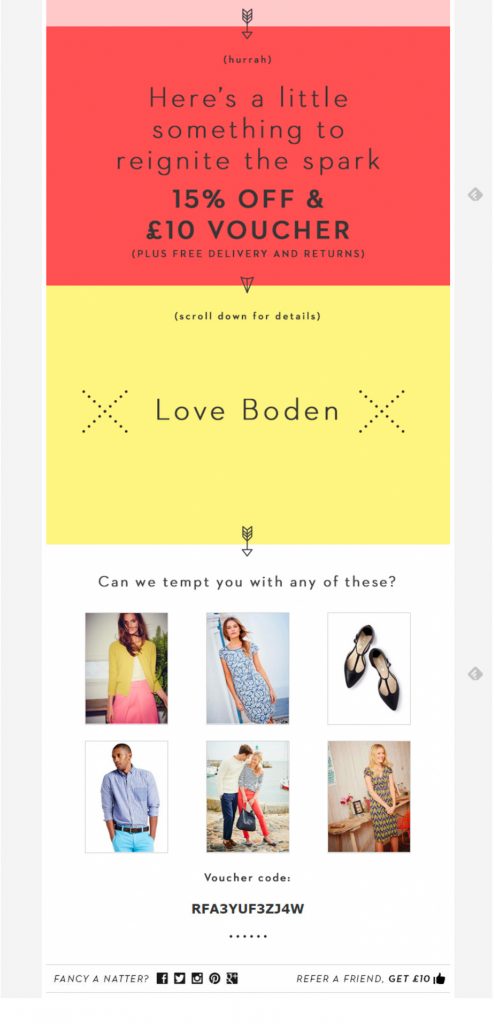Email personalisation and contextual marketing are important strategies to increase revenue for any business. By leveraging the data available from customers, businesses can target their communications more effectively to create an engaging customer experience. This ultimately leads to higher conversions and more sales.
Personalisation of emails allows businesses to deliver content that is tailored specifically for each individual customer. This can include things like offering products that are relevant to the customer’s interests, or including content based on their past interactions with the business. In addition, businesses can also use data from their customers’ browsing history and other website activity to target their communications more effectively. For example, if a customer has been viewing shoes on your website, you could send them an email about a new discount on shoes that they might be interested in.
Contextual marketing is another strategy that businesses can use to increase revenue. By analyzing data from customer interactions and other sources, businesses can create customized content based on the specific context of each interaction. For example, if a customer has just purchased a product from your website, you might send them an email that promotes a related product or service. By understanding the context of each interaction, businesses can create more targeted and effective marketing campaigns that are more likely to result in higher conversions and sales.
Overall, email personalisation and contextual marketing can create more targeted and effective marketing campaigns that result in higher conversions and sales.
How to increase revenue with email personalisation and contextual marketing
Email personalisation and contextual marketing are two effective ways to increase revenue. By personalizing emails, you can make a connection with the reader and encourage them to take action. Contextual marketing allows you to send relevant, targeted messages to readers based on their interests and needs.
Both email personalisation and contextual marketing require careful planning and execution. But when done well, they can be powerful tools for increasing revenue.
Perhaps one of the most popular case studies we can learn from is Amazon. In order to increase revenue, Amazon used email personalisation and contextual marketing to improve the customer experience. By utilizing data from customers’ past purchases and behavior, they were able to send highly relevant emails which resulted in increased conversion rates. In addition, they used geographical data to provide targeted recommendations and offers which were then tailored to each individual customer. As a result of this targeted approach, Amazon saw a significant increase in revenue.
But Amazon is not the only retailer that has got its bet on skyrocketing profits through email personalization and contextual marketing. There’s another retailer that has set the ball rolling.
Best Example of Personalization and Contextual Marketing
Boden, a fashion retailer, is an example of a company that uses data to personalize its emails and improve their marketing efforts. Through the use of personalization and contextual marketing, Boden seeks to create relevant emails that resonate with customers and drive sales.
Boden is able to use email personalisation and contextual marketing to provide its customers with relevant, targeted content that is tailored to their individual needs and preferences. By utilizing customer data such as purchase history, browsing behavior and location, Boden can send highly personalized emails that include recommendations for products, services and content that are relevant to the customer. This allows Boden to build strong relationships with its customers and continue to grow its business.
Boden uses data by segmenting customers based on their interests and behaviors. By doing this, they can send different types of emails to each customer segment and optimize the content according to their needs. For example, if a customer is highly engaged with Boden’s social media presence, they might receive email communications related to product updates or exclusive offers on social media-related items.
This email below by Boden highlighted the special connection a customer has with a brand from their very first purchase to their very last.

Using information gathered from consumers’ prior purchases, Boden used customization tools to tailor unique emails for every customer.

At the end of the same email, Boden also plugged-in the much-needed product recommendation section alongside a special offer. All of this personalisation is made possible with the help of technology that automatically pulls data from Boden’s website and adds relevant and in-stock products in the email. In the event that a product was out of stock at the time the email was viewed, a suitable replacement would be shown.
The click-through rate for the campaign was 230% higher than that for regular emails delivered the same week. A whopping 2000% boost in revenue per email was achieved as a result, with 1 in 10 customers ultimately making a purchase.
Overall, data played a critical role in helping businesses like Boden to personalize their email marketing efforts and improve their revenue. By understanding customers’ interests and preferences, companies can create relevant emails that resonate with customers and drive sales. This demonstrates the power of data-driven marketing in modern business contexts.
4 Steps to Follow for Better Email Personalization and Contextual Marketing
Follow these four steps to begin your email personalization journey:
Find the Right Platform for Personalization
Personalization is a recurring refrain in marketing teams, But that usually means adding a customer’s initial name and making suggestions based on their past purchases. Brands need to reach their target audience with the right content targeted at the right time. All this begins with choosing the right personalization platform for your brand to arm you with all the technologies needed to serve your customers better! This is where RetainIQ comes into the picture for you — a powerful and AI-assisted hyper-personalization platform dedicated to performance and optimization. With RetainIQ by your side, you can seamlessly integrate multiple data sources and personalize to target your audience of 1 with ease; moreover, it is an assistant that allows you to run your next retention campaigns on autopilot and provides you with incredible insights and boost revenues.
Keep Testing and Reporting
Brands need to use data to properly segment customers under a section defined by products they like. This is just the tip of the iceberg, though. What follows is rigorous testing and reporting based on each segment and improvement from results.
Build Persona
The next step after segmentation is the persona building. You need to build personas based on available data. For example – You can build two buyer personas A and B based on their preferences and history. This way, you can serve targeted offers, recommendations, and content to your customers that will resonate with them.
Customer Journey
Develop a cross-channel communication strategy by using various online and offline marketing channels in tandem with automated, highly tailored email communications made possible by advanced marketing tools and technologies.
Conclusion
Email personalization and contextual marketing are powerful tools for increasing revenue, yet they can be very tricky to get right. With the right strategy and approach, however, these techniques can prove to be extremely effective in helping your business expand its reach and customer base. By using email personalization and contextual marketing tactics throughout all of your messaging across digital channels, you will be able to provide customers with a more memorable experience that leads to higher engagement rates. Don’t forget: The key is to stay focused on understanding what makes each individual customer tick so that you can deliver content that resonates with them.

